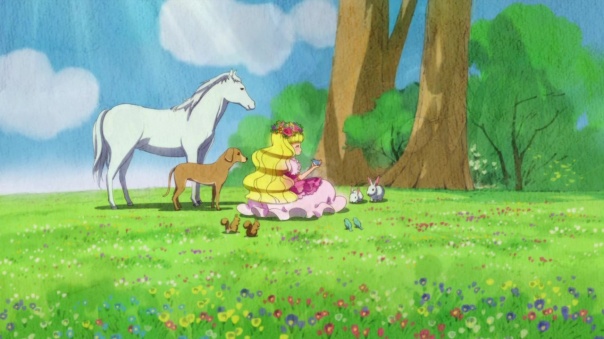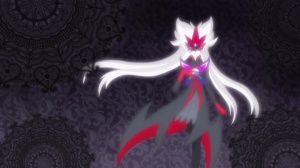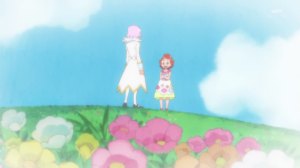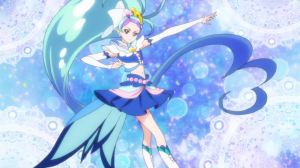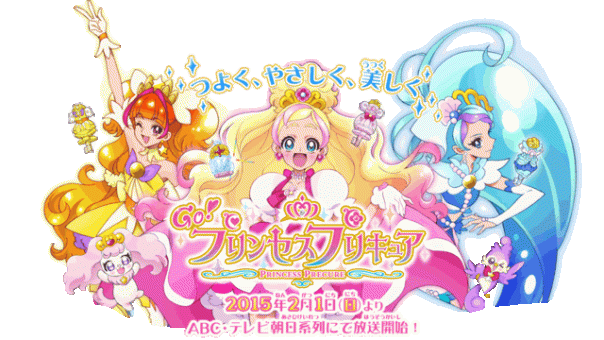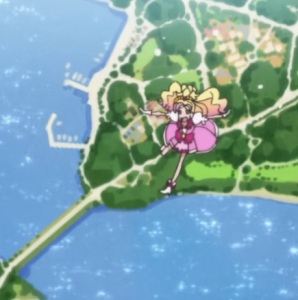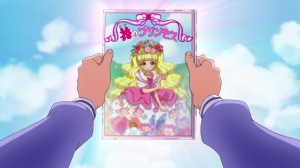 Episode 20 of Go! Princess Precure has recently aired, and the story is starting to unfold. In Episode 18, we met the author of the book that inspired Haruka-chan’s dream of becoming a princess. The protagonist of this book was the Princess of Flowers, who was loved by everyone. One day, a bird became jealous of her popularity and betrayed her to an evil magic user who held her prisoner. During her time of captivity, the princess never became angry or bitter, but instead remained sweet and kind. The bird regretted betraying the princess and helped her get free. The bird apologized to the princess, who forgave the bird, and they all became good friends.
Episode 20 of Go! Princess Precure has recently aired, and the story is starting to unfold. In Episode 18, we met the author of the book that inspired Haruka-chan’s dream of becoming a princess. The protagonist of this book was the Princess of Flowers, who was loved by everyone. One day, a bird became jealous of her popularity and betrayed her to an evil magic user who held her prisoner. During her time of captivity, the princess never became angry or bitter, but instead remained sweet and kind. The bird regretted betraying the princess and helped her get free. The bird apologized to the princess, who forgave the bird, and they all became good friends.
Not only did this story inspire Haruka-chan’s dream, but it also inspired the dream of her roommate, Yui-chan, who wants to become an author of children’s books. We find out that the author of the story was inspired to create a character based on who she wanted her daughter to grow up to be.
 Aside from the Cure Princesses, there is another Princess on the side of evil, Princess Twilight. We discover, at the end of episode 20, that Princess Twilight is likely Princess Towa, the younger sister of Prince Kanata. There was a time when she shared the same dream as the Princess Precure, to become a Grand Princess. In order to become a Grand Princess, the girls must become 強い tsuyosi (“strong”), 優しい yasashii (“gentle”), and 美しい utsukushii (“beautiful”).
Aside from the Cure Princesses, there is another Princess on the side of evil, Princess Twilight. We discover, at the end of episode 20, that Princess Twilight is likely Princess Towa, the younger sister of Prince Kanata. There was a time when she shared the same dream as the Princess Precure, to become a Grand Princess. In order to become a Grand Princess, the girls must become 強い tsuyosi (“strong”), 優しい yasashii (“gentle”), and 美しい utsukushii (“beautiful”).
We discover that Princess Towa had been missing for some time, and that without her the Hope Kingdom became unable to resist Dyspear. When Prince Kanata and the Princess Precure find her in episode 20, she does not recognize Prince Kanata and she believes herself to be the daughter of Dyspear.
As Princess Twilight, she sees herself as the 唯一無二 yuiitsumuni (“one and only”) Princess and she describes herself as 気高い, kedakai (“noble”), 尊い toutoi (“precious, valuable”), and 麗しい uruwashii (“beautiful”). It is interesting because these traits do not seem bad in and of themselves. Indeed, my Japanese is not at the level yet where I can understand the difference in meaning or nuance between the two words for beautiful, 美しい utsukushii and 麗しい uruwashii, except that 美しい utsukushii is a much more common word, from what I can tell. I learned 美しい utsukushii quite early on my studies, and hear and read it all of the time. I think that I learned 麗しい uruwashii from this series, and I do not know if I have seen it anywhere else as of yet.
Yet, judging from the other two ideals, that may very well be the important difference in the two words for beautiful. Strength and gentleness are used to support other people. Being noble and precious can be forms of setting oneself apart from others. Another clue is that she refers to herself as the “one and only” Princess.
It will be interesting to see what happens next. It is highly likely that Princess Twilight will return to her true self as Princess Towa. Aside from things of this nature being common in Precure, her apparent theme seems to be that of the butterfly, the symbol of transformation. It will also be interesting to discover the true nature of Dyspear. Is she truly Princess Towa’s mother and the Queen of Hope Kingdom under a spell of a larger force of Evil?
I am looking forward to the coming episodes!
